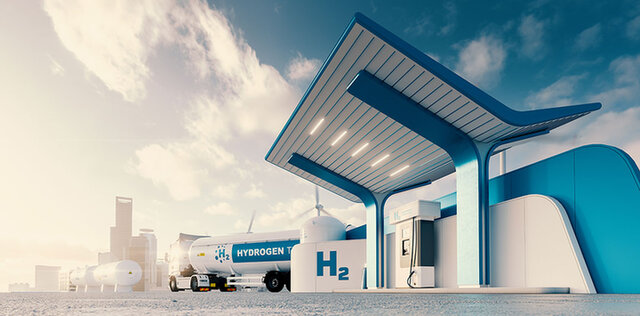
Sustainability
Powering a sustainable future: the rise of green hydrogen
Green hydrogen, produced using renewable energy sources like wind and solar through water electrolysis, is gaining prominence as a sustainable energy carrier.
With the global drive to achieve net-zero emissions, green hydrogen offers a promising pathway to decarbonise industries, transport, and energy systems. This article explores the technological advancements, scalability, challenges, and future outlook of green hydrogen.
Technological advancements in green hydrogen
The production of green hydrogen relies on electrolysis, where water is split into hydrogen and oxygen using electricity. Recent advancements in electrolyser technology have significantly improved efficiency, bringing down the cost of production. Two main types of electrolysers, Proton Exchange Membrane (PEM) and Alkaline Electrolysers, are leading the charge in the green hydrogen revolution.
- Proton Exchange Membrane (PEM) electrolysers
Known for their ability to operate dynamically and handle variable electricity input from renewable sources, PEM electrolysers are ideal for integrating with wind and solar power systems. - Solid oxide electrolysers
These high-temperature devices offer higher efficiencies and can utilise waste heat from industrial processes, further reducing energy consumption.
The development of larger, modular electrolysers has enabled economies of scale, with projects such as the European Union's HyDeal Ambition targeting green hydrogen production at $1.50 per kilogram by 2030.
By converting surplus energy into hydrogen, it can be stored and later used to generate electricity through fuel cells or turbines.
Scalability and industrial applications
Green hydrogen is poised to play a vital role in sectors that are hard to electrify:
- Heavy industry
Steel manufacturing, which contributes approximately 8% of global CO2 emissions, can significantly reduce its carbon footprint by replacing coal with hydrogen in direct reduction processes. Companies like ArcelorMittal are already piloting hydrogen-based steel production. - Transportation
Hydrogen fuel cell vehicles (HFCVs) offer a viable alternative for decarbonising long-haul trucking, shipping, and aviation, where battery technology faces limitations. The aviation industry is exploring hydrogen-powered aircraft, with Airbus announcing plans for a zero-emission hydrogen plane by 2035. - Energy storage
Green hydrogen can store excess renewable energy, addressing intermittency challenges. By converting surplus energy into hydrogen, it can be stored and later used to generate electricity through fuel cells or turbines.
The absence of a global hydrogen network remains a bottleneck for widespread adoption.

Challenges in scaling green hydrogen
Despite its potential, green hydrogen faces several challenges:
- Cost competitiveness
Green hydrogen is currently more expensive than grey hydrogen (produced from natural gas). Subsidies, carbon pricing, and advancements in renewable energy will be critical to narrowing this gap. - Infrastructure development
Building a hydrogen economy requires extensive infrastructure, including pipelines, storage facilities, and refuelling stations. The absence of a global hydrogen network remains a bottleneck for widespread adoption. - Energy losses
The process of producing, storing, and converting hydrogen involves energy losses. Efficiency improvements across the value chain are necessary to maximise its sustainability benefits. - Water resource management
Electrolysis demands significant amounts of water. In regions facing water scarcity, this could pose a challenge to the scalability of green hydrogen projects.
The European Hydrogen Backbone aim to establish a transcontinental pipeline network, enabling hydrogen transport across member states.
Case studies and global initiatives
- Australia’s hydrogen superpower strategy
Australia is leveraging its abundant solar and wind resources to develop large-scale green hydrogen projects, such as the Asian Renewable Energy Hub. The country aims to export hydrogen to Asian markets, including Japan and South Korea. - European Union's hydrogen roadmap
The EU has committed to producing 10 million tonnes of green hydrogen annually by 2030. Initiatives like the European Hydrogen Backbone aim to establish a transcontinental pipeline network, enabling hydrogen transport across member states. - India’s National Hydrogen Mission
India launched its National Hydrogen Mission in 2021 to become a hub for hydrogen production and export. The country is investing in domestic electrolyser manufacturing and renewable energy integration to drive down costs.
Future outlook
The future of green hydrogen depends on technological innovation, policy support, and collaboration across industries and governments. Key developments that could shape its trajectory include:
- Innovative financing models
Public-private partnerships and green bonds are emerging as tools to fund hydrogen infrastructure and projects. - Carbon pricing
A robust carbon pricing mechanism can incentivise industries to adopt green hydrogen over fossil fuels, accelerating its market penetration. - International collaboration
Multinational partnerships, such as the Hydrogen Council, are fostering knowledge-sharing and investment in hydrogen technology. - Hybrid systems
Integration of hydrogen with renewable energy sources and carbon capture technologies will enhance its viability as a cornerstone of the energy transition.
Public-private partnerships and green bonds are emerging as tools to fund hydrogen infrastructure and projects.
Conclusion
Green hydrogen represents a transformative opportunity to decarbonise some of the most challenging sectors of the global economy. By harnessing renewable energy and scaling technological advancements, green hydrogen can drive the transition towards a sustainable future. While challenges remain, strategic investments, policy frameworks, and international cooperation can unlock its full potential, making green hydrogen a cornerstone of the global energy mix.